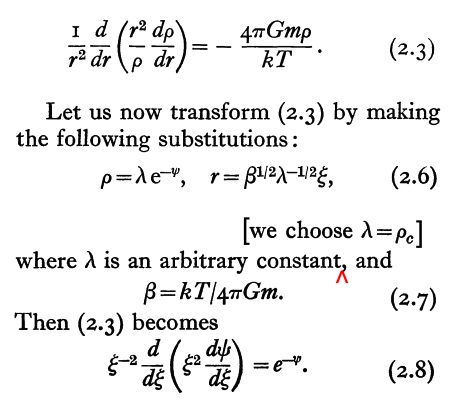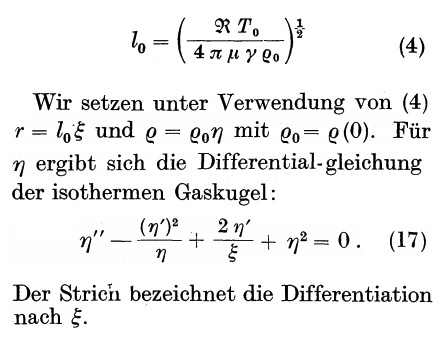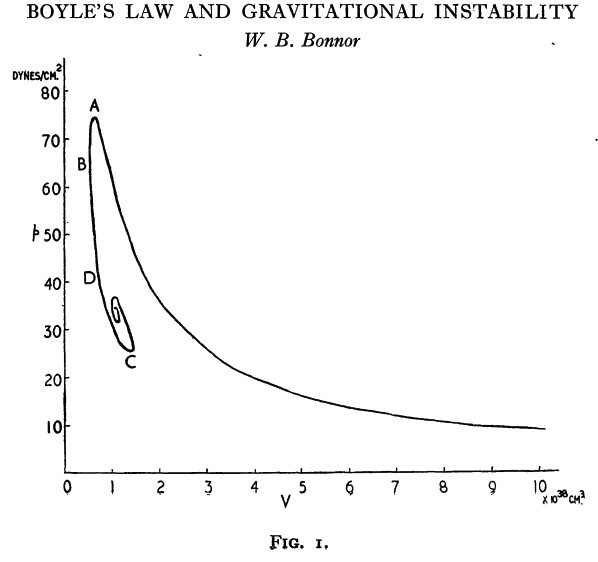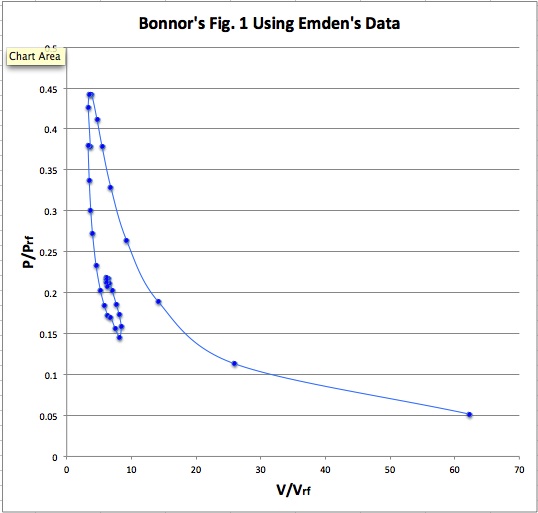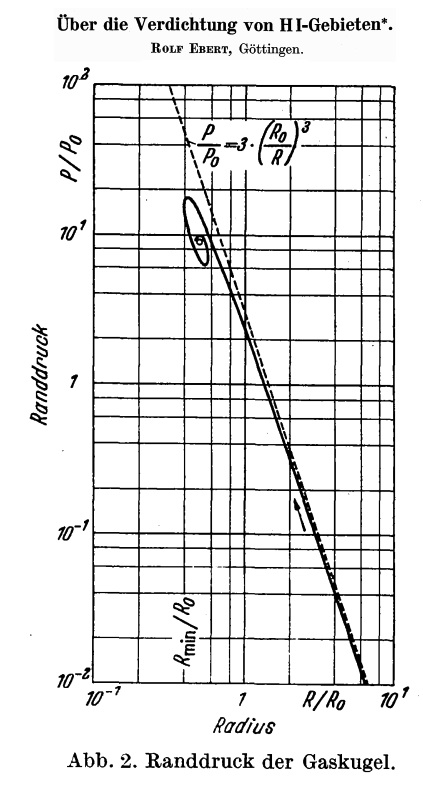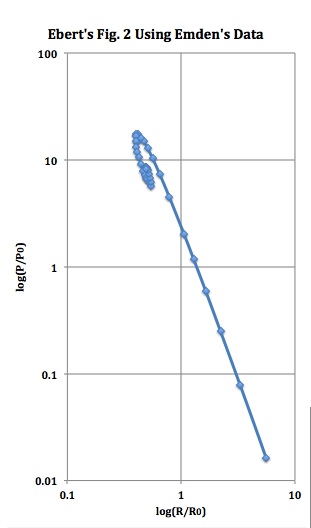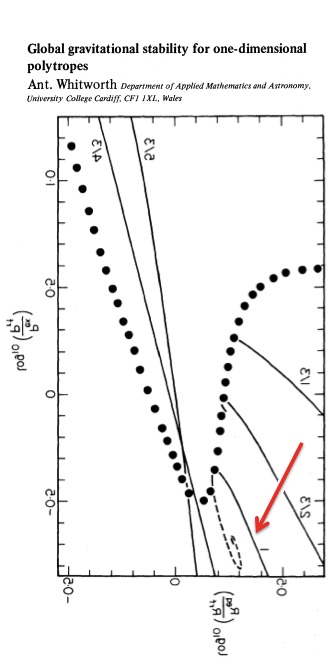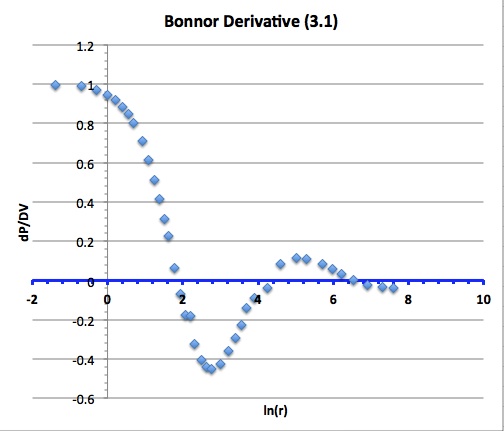Difference between revisions of "User:Tohline/SSC/Structure/BonnorEbert"
(→P-V Diagram: Insert new set of Ebert-Whitworth comparison figures) |
(→P-V Diagram: Continue to weave Ebert's derivation into the discussion) |
||
| Line 145: | Line 145: | ||
</div> | </div> | ||
Ebert chose to illustrate the behavior of the sequence of pressure-bounded isothermal spheres by plotting <math>\log(P/P_0)</math> versus <math>\log(R/R_0)</math>, rather than P versus V. The result — Figure 2 in [http://adsabs.harvard.edu/abs/1955ZA.....37..217E Ebert (1955)] — is reproduced here as the left-hand panel of our Figure 2. It should be clear that the ''information'' contained in Ebert's plot is identical to the ''information'' contained in the curve that is displayed in Bonner's P-V diagram. | |||
<div align="center"> | <div align="center"> | ||
| Line 151: | Line 151: | ||
<tr> | <tr> | ||
<td align="center" colspan="3"> | <td align="center" colspan="3"> | ||
'''Figure 2: | '''Figure 2: Ebert's and Whitworth's P-R Diagrams''' | ||
</td> | </td> | ||
</tr> | </tr> | ||
| Line 168: | Line 168: | ||
</div> | </div> | ||
In an effort to demonstrate more explicitly how Bonnor's 1956 work and | In an effort to demonstrate more explicitly how Bonnor's 1956 work and Ebert's 1955 work tie back to the original work on isolated isothermal spheres that was published by Emden in 1907, the right-hand panel of our Figure 1 shows a plot of <math>P_e/P_0</math> versus <math>V/V_0</math>, and the middle panel of our Figure 2 shows a plot of <math>\log(P_e/P_0)</math> versus <math>\log(R/R_0)</math> that we have constructed using data drawn directly from [[User:Tohline/SSC/Structure/IsothermalSphere#Emden.27s_Numerical_Solution|Table 14 of Emden (1907)]]. | ||
===Whitworth's Normalization=== | ===Whitworth's Normalization=== | ||
| Line 189: | Line 189: | ||
</math> | </math> | ||
</div> | </div> | ||
As another point of reference, the expressions we have presented for <math>P_e/P_\mathrm{rf}</math> and <math>R/R_\mathrm{rf}</math> are identical to the pair of equations labeled (9b) in [http://adsabs.harvard.edu/abs/1981MNRAS.195..967W Whitworth (1981)]. In the context of his discussion of the global stability of one-dimensional polytropes, Whitworth chose to illustrate the behavior of the sequence of pressure-bounded isothermal spheres by plotting <math>\log(R/R_\mathrm{rf})</math> versus <math>\log(P/P_\mathrm{rf})</math>, rather than "P" versus "V;" the result is the curve labeled "1" in his Fig. 1b, which is reproduced here as the left-hand panel of our Figure 2. It should be clear that the ''information'' contained in Whitworth's plot (specifically, his curve labeled "1") is identical to the ''information'' contained in the curve that is displayed in Bonner's P-V diagram. | |||
==Limiting Pressure and Maximum Mass== | ==Limiting Pressure and Maximum Mass== | ||
Revision as of 01:54, 23 June 2013
Pressure-Bounded Isothermal Sphere

|
|---|
| | Tiled Menu | Tables of Content | Banner Video | Tohline Home Page | |
As has been derived and discussed elsewhere, an isolated isothermal sphere has a density profile that extends to infinity and, correspondingly, an unbounded total mass. In an astrophysical context, neither of these properties is desirable. A more realistic isothermal configuration can be constructed by embedding the structure in a low density, but hot external medium whose pressure, <math>P_e</math>, confines the isothermal configuration to a finite size. In a mathematical model, this can be accomplished by ripping off an outer layer of the isolated isothermal configuration down to the radius — label it <math>\xi_e</math> — at which the configuration's original (internal) pressure equals <math>P_e</math>; the interior of the configuration that remains — containing mass <math>M_{\xi_e}</math> — should be unaltered and in equilibrium. (This will work only for spherically symmetric configurations, as the gravitational acceleration at any location only depends on the mass contained inside that radius.) Ebert (1955) and Bonnor (1956) are credited with constructing the first such models and, most significantly, discovering that, for any specified sound speed and applied external pressure, there is a mass above which no equilibrium configuration exists. We present, here, the salient elements of these (essentially equivalent) derivations.
Prior to studying this discussion of pressure-bounded isothermal spheres, we recommend studying our related discussion of pressure-bounded <math>~n</math> = 5 polytropes. As with isolated isothermal spheres, isolated <math>~n</math> = 5 polytropes extend to infinity. But, unlike their isothermal counterparts, the structure of <math>~n</math> = 5 polytropes is describable analytically. Hence, an analysis of their structure and its extension to pressure-bounded configurations avoids the clutter introduced by a model — such as the isothermal sphere — that can only be described numerically. As it turns out, the pressure-bounded <math>~n</math> = 5 polytrope exhibits a Bonnor-Ebert type limiting mass that is analytically prescribable. Its derivation is mathematically quite clean and provides a firm foundation for understanding the better known — but only numerically prescribable — Bonnor-Ebert limiting mass.
Governing Relation
The equilibrium structure of an isolated isothermal sphere, as derived by Emden (1907), has been discussed elsewhere. From this separate discussion we appreciate that the governing ODE is,
<math>\frac{1}{r^2} \frac{d}{dr}\biggl( r^2 \frac{d\ln\rho}{dr} \biggr) =- \frac{4\pi G}{c_s^2} \rho \, ,</math>
where,
<math>c_s^2 = \frac{\Re T}{\bar{\mu}} = \frac{k T}{m_u \bar{\mu}} \, ,</math>
is the square of the isothermal sound speed. In their studies of pressure-bounded isothermal spheres, Ebert (1955, ZA, 37, 217) and Bonnor (1956, MNRAS, 116, 351) both started with this governing ODE, but developed its solution in different ways. Here we present both developments while highlighting transformations between the two.
| Derivation by Bonnor (edited) | translation | Derivation by Ebert (edited) |
| <math>G \Leftrightarrow \gamma</math> | ||
| <math>\rho_c \Leftrightarrow \rho_0</math> | ||
| <math>\frac{kT}{m} \Leftarrow c_s^2 \Rightarrow \frac{\Re T_0}{\mu}</math> | ||
| <math>\beta^{1/2}\lambda^{-1/2} \Leftrightarrow l_0</math> | ||
| <math>e^{-\psi} \Leftrightarrow \eta</math> |
Both of these dimensionless governing ODEs — Bonnor's Eq. (2.8) and Ebert's Eq. (17) — are identical to the dimensionless expression derived by Emden (see the presentation elsewhere), namely,
<math> \frac{d^2v_1}{d\mathfrak{r}_1^2} +\frac{2}{\mathfrak{r}_1} \frac{dv_1}{d\mathfrak{r}_1} + e^{v_1} = 0 \, . </math>
The translation from Emden-to-Bonnor-to-Ebert is straightforward:
<math> \mathfrak{r}_1 = \xi|_\mathrm{Bonner} = \xi|_\mathrm{Ebert}~~~~\mathrm{and}~~~~e^{v_1} = e^{-\psi} = \eta \, . </math>
In much of what follows, we will use Bonnor's <math>(\xi, \psi)</math> notation rather than Emden's <math>(\mathfrak{r}_1, v_1)</math> notation.
P-V Diagram
Given a value for the isothermal sound speed, <math>c_s</math>, and the central density, <math>\rho_c</math>, our accompanying summary of the properties of an isothermal sphere, as derived by Emden (1907), provides the following structural relations:
- Radial Coordinate Position & Associated Volume:
<math>r = \biggl( \frac{c_s^2}{4\pi G \rho_c} \biggr)^{1/2} \xi </math> ;
<math>V \equiv \frac{4\pi}{3} r^3 = \frac{4\pi}{3} \biggl( \frac{c_s^2}{4\pi G \rho_c} \biggr)^{3/2} \xi^3 </math> ;
- Pressure Profile:
<math>P = (c_s^2 \rho_c) e^{-\psi}</math>;
- Enclosed Mass:
<math> M_r = \biggl( \frac{c_s^6}{4\pi G^3 \rho_c} \biggr)^{1/2} \biggl[ - \xi^2 \frac{d\psi}{d\xi} \biggr] \, . </math>
Bonnor and Ebert both asked how the surface pressure of a truncated isothermal sphere of a given sound speed — or, equivalently, how the external pressure, <math>P_e</math>, required to confine that truncated configuration — will vary with volume if the mass <math>M_{\xi_e}</math> of the configuration, rather than the central density, is held fixed. The above expression for the enclosed mass can be inverted to give <math>\rho_c</math> in terms of <math>M_{\xi_e}</math>; specifically,
<math> \rho_c = \biggl( \frac{c_s^6}{4\pi G^3 M_{\xi_e}^2} \biggr) \biggl[ - \xi^2 \biggl(\frac{d\psi}{d\xi}\biggr) \biggr]_e^2 \, , </math>
where the subscript <math>e</math> denotes a truncated configuration of radius <math>\xi_e</math> confined by an external pressure. This allows us to replace <math>\rho_c</math> in favor of <math>M_{\xi_e}</math> in the expressions for both the pressure and volume, obtaining,
- Pressure:
<math>P_e = \biggl( \frac{c_s^8}{4\pi G^3 M_{\xi_e}^2} \biggr) ~\xi_e^4 \biggl(\frac{d\psi}{d\xi}\biggr)^2_e e^{-\psi_e} \, ,</math>
- or, adopting Ebert's (1955) normalization pressure, <math>P_0 \equiv c_s^8/(4\pi G^3 M_{\xi_e}^2)</math> — see his equation (22),
<math>\frac{P_e}{P_0} = \xi_e^4 \biggl(\frac{d\psi}{d\xi}\biggr)^2_e e^{-\psi_e} \, ;</math>
- Volume:
<math>V^2 = \biggl( \frac{4\pi}{3} \biggr)^2 \biggl( \frac{c_s^2}{4\pi G} \biggr)^{3} \biggl( \frac{4\pi G^3 M_{\xi_e}^2}{c_s^6} \biggr)^3 \biggl[ - \xi^2 \biggl(\frac{d\psi}{d\xi}\biggr) \biggr]_e^{-6} \xi_e^6 = \biggl( \frac{4\pi}{3} \biggr)^2 \biggl( \frac{G^6 M_{\xi_e}^6}{c_s^{12}} \biggr) \biggl[ - \xi^2 \biggl(\frac{d\psi}{d\xi}\biggr) \biggr]_e^{-6} \xi_e^6 \, , </math>
<math> \Rightarrow ~~~~~ V = \frac{4\pi}{3} \biggl( \frac{G M_{\xi_e}}{c_s^{2}} \biggr)^3 \biggl[ - \xi \biggl(\frac{d\psi}{d\xi}\biggr) \biggr]_e^{-3} \, ; </math>
- or, adopting a normalization volume, <math>V_0 \equiv (4\pi/3)R_0^3</math>, defined in terms of Ebert's (1955) normalization radius, <math>R_0 \equiv G M_{\xi_e}/c_s^2</math> — again, see his equation (22),
<math> \frac{V}{V_0} = \biggl[ - \xi \biggl(\frac{d\psi}{d\xi}\biggr) \biggr]_e^{-3} \, ; </math>
- the corresponding normalized radius of the truncated configuration is,
<math> \frac{R}{R_0} = \biggl(\frac{V}{V_0}\biggr)^{1/3} = \biggl[ - \xi \biggl(\frac{d\psi}{d\xi}\biggr) \biggr]_e^{-1} \, . </math>
The expressions shown here for <math>P_e</math> and <math>V</math> are identical to those presented by Bonnor (1956) for "<math>p</math>" and "<math>V</math>," immediately following his equation (2.17). They are also the set of parametric equations that lead to Bonnor's Fig. 1 P-V diagram, which is reproduced here as the left-hand panel of our Figure 1.
Ebert chose to illustrate the behavior of the sequence of pressure-bounded isothermal spheres by plotting <math>\log(P/P_0)</math> versus <math>\log(R/R_0)</math>, rather than P versus V. The result — Figure 2 in Ebert (1955) — is reproduced here as the left-hand panel of our Figure 2. It should be clear that the information contained in Ebert's plot is identical to the information contained in the curve that is displayed in Bonner's P-V diagram.
In an effort to demonstrate more explicitly how Bonnor's 1956 work and Ebert's 1955 work tie back to the original work on isolated isothermal spheres that was published by Emden in 1907, the right-hand panel of our Figure 1 shows a plot of <math>P_e/P_0</math> versus <math>V/V_0</math>, and the middle panel of our Figure 2 shows a plot of <math>\log(P_e/P_0)</math> versus <math>\log(R/R_0)</math> that we have constructed using data drawn directly from Table 14 of Emden (1907).
Whitworth's Normalization
- or, normalized to the isothermal reference pressure, <math>P_\mathrm{rf} = (3^4 \cdot 5^3/2^{10}\pi) c_s^8 G^{-3} M_{\xi_e}^{-2}</math>, as defined by Whitworth (1981) — for clarification, read the accompanying ASIDE —
<math>\frac{P_e}{P_\mathrm{rf}} = \biggl( \frac{2^8}{3^4\cdot 5^3} \biggr) ~\xi_e^4 \biggl(\frac{d\psi}{d\xi}\biggr)^2_e e^{-\psi_e}</math>;
- or, normalized to the isothermal reference volume, <math>V_\mathrm{rf} \equiv (4\pi /3) R_\mathrm{rf}^3</math>, where, as defined by Whitworth (1981) <math>R_\mathrm{rf} = (2^2 / 3 \cdot 5) G M_{\xi_e} c_s^{-2} </math> — for clarification, read the accompanying ASIDE —
<math> \frac{V}{V_\mathrm{rf}} = \frac{3^3\cdot 5^3}{2^6} \biggl[ - \xi \biggl(\frac{d\psi}{d\xi}\biggr) \biggr]_e^{-3} \, ; </math>
- the corresponding normalized radius of the truncated configuration is,
<math> \frac{R}{R_\mathrm{rf}} = \biggl(\frac{V}{V_\mathrm{rf}}\biggr)^{1/3} = \frac{3\cdot 5}{2^2} \biggl[ - \xi \biggl(\frac{d\psi}{d\xi}\biggr) \biggr]_e^{-1} \, . </math>
As another point of reference, the expressions we have presented for <math>P_e/P_\mathrm{rf}</math> and <math>R/R_\mathrm{rf}</math> are identical to the pair of equations labeled (9b) in Whitworth (1981). In the context of his discussion of the global stability of one-dimensional polytropes, Whitworth chose to illustrate the behavior of the sequence of pressure-bounded isothermal spheres by plotting <math>\log(R/R_\mathrm{rf})</math> versus <math>\log(P/P_\mathrm{rf})</math>, rather than "P" versus "V;" the result is the curve labeled "1" in his Fig. 1b, which is reproduced here as the left-hand panel of our Figure 2. It should be clear that the information contained in Whitworth's plot (specifically, his curve labeled "1") is identical to the information contained in the curve that is displayed in Bonner's P-V diagram.
Limiting Pressure and Maximum Mass
No matter how you look at the bounded isothermal sphere sequence — whether plotted as a curve in Bonnor's P-V diagram or as a curve in Whitworth's R-P diagram — it is clear that, for a given choice of the sound speed and the mass, there is a value of the pressure above which no equilibrium configuration exists. (Alternatively, for a given sound speed and external pressure, there is a limiting mass above which no equilibrium configuration exists; see below.) The configuration identifying this limiting pressure resides at the position along Bonnor's P-V diagram sequence where <math>dP_e/dV</math> — or, in Whitworth's discussion, <math>dP_e/dR</math> — first goes to zero.
Following Bonnor's Presentation
As is shown in his equation (3.1), Bonnor (1956) determined that, at a fixed mass and sound speed, <math>dP/dV</math> goes to zero when,
<math>1-\frac{1}{2} e^{\psi} \biggl( \frac{d\psi}{d\xi}\biggr)^2 = 0 \, .</math>
In the following figure, the function defined by the left-hand-side of this expression is plotted versus <math>\ln\xi</math> using Emden's (1907) tabulated data. As Bonnor noted, the function first crosses zero when <math>\xi \approx 6.5</math> (<math>\ln\xi = 1.87</math>).
An isothermal sphere that is truncated at this location will have a radius,
<math> R = \biggl( \frac{c_s^2}{G\rho_c} \biggr)^{1/2} \frac{6.5}{\sqrt{4\pi}} = 1.83 \biggl( \frac{c_s^2}{G\rho_c} \biggr)^{1/2} \, , </math>
which matches equation (3.3) of Bonnor (1956); and, drawing on function values provided in Emden's (1907) Table 14, it will have a total mass,
<math>M_R = \biggl( \frac{c_s^6}{4\pi G^3 \rho_c} \biggr)^{1/2} \biggl[- \xi^2 \frac{d\psi}{d\xi} \biggr]_e \approx \biggl( \frac{c_s^6}{G^3 \rho_c} \biggr)^{1/2} \biggl[ \frac{(14.353+17.214)/2}{\sqrt{4\pi}} \biggr] = 4.45 \biggl( \frac{c_s^6}{G^3 \rho_c} \biggr)^{1/2}\, .</math>
Dividing this expression for <math>M_R</math> by the expression for <math>R</math> gives,
<math> \frac{M_R}{R} = 2.43 \biggl( \frac{c_s^2}{G} \biggr) \, , </math>
which matches equation (3.6) of Bonnor (1956). In order to maintain an equilibrium structure while truncating the isothermal model at this radius requires applying an external pressure of the following magnitude:
<math>P_e = c_s^2 \rho_c e^{-\psi} \approx c_s^2 \rho_c (0.08493 + 0.05833)/2 = 0.0716~ c_s^2 \rho_c \, ,</math>
where, again, numerical values have been drawn from Emden's (1907) Table 14.
Finally, using this relation to eliminate <math>\rho_c</math> from the expression for <math>M_R</math> gives,
|
<math>M_R</math> |
= |
<math>\biggl( \frac{c_s^8}{G^3 P_e} \biggr)^{1/2}\biggl[ \frac{1}{4\pi}\biggr]^{1/2} \biggl[\xi^2 e^{\psi/2} \biggl(-\frac{d\psi}{d\xi} \biggr) \biggr]_e</math> |
|
|
<math>\approx</math> |
<math> \biggl( \frac{c_s^8}{G^3 P_e} \biggr)^{1/2} \frac{1}{2\pi^{1/2}} \biggl\{ \frac{1}{2} \biggl[ 14.353 (0.08493)^{1/2} + 17.214 (0.05833)^{1/2} \biggr] \biggr\} </math> |
|
|
<math>\approx</math> |
<math> 1.18 \biggl( \frac{c_s^8}{G^3 P_e} \biggr)^{1/2} \, . </math> |
This is the mass upper limit for a stable, pressure-bounded isothermal sphere — the so-called Bonnor-Ebert mass; see, for example, equation (1) of Shu (1977). In a separate discussion, we compare this result to the determinations of other related mass upper-limits.
Ebert's Corresponding Presentation
The expression derived by Bonnor for the ratio <math>M_R/R</math> in the limiting configuration can be inverted to give,
<math> R \approx 0.41 \biggl( \frac{G M_R}{c_s^2} \biggr) \, . </math>
This matches the expression for the critical radius, <math>R_\mathrm{kr}</math>, that appears as equation (23) in Ebert's (1955) published derivation. Similarly, the above relation that expresses the Bonnor-Ebert limiting mass in terms of <math>c_s</math>, <math>G</math>, and <math>P_e</math> can be inverted to give,
<math> P_e \approx 4\pi (1.18)^2 \biggl( \frac{c_s^8}{4\pi G^3 M_R^2} \biggr) = 17.5 \biggl( \frac{c_s^8}{4\pi G^3 M_R^2} \biggr) \, , </math>
which agrees with the limiting pressure that was derived by Ebert (1955) and that is also presented in his equation (23).
Related Discussions
- Bonnor-Ebert Mass according to Wikipedia
- A MATLAB script to determine the Bonnor-Ebert Mass coefficient developed by Che-Yu Chen as a graduate student in the University of Maryland Department of Astronomy

|
|---|
|
© 2014 - 2021 by Joel E. Tohline |
